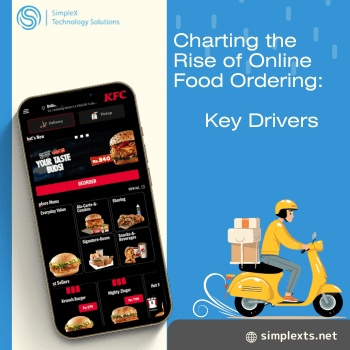Embracing the Digital Dining Revolution: Unveiling the Surge of Online Food Ordering
In an era marked by technological advancements and shifting consumer preferences, the food industry has experienced a profound transformation, thanks to the rise of online food ordering systems. With the advent of digital platforms, ordering food has never been more convenient. From traditional restaurant dine-ins to online delivery and takeout options, the landscape has evolved significantly. This article delves into the key drivers behind the surge of online food ordering, exploring the role of technology and its impact on restaurants, consumers, and the industry as a whole.
Online Food Delivery Revolution and Global Market Dynamics
The rapid growth of the online food delivery market is undeniable, with projections indicating substantial expansion in the coming years. Globally, this sector is poised to achieve remarkable heights, with a projected value of $286.4 billion by 2026, boasting a remarkable Compound Annual Growth Rate (CAGR) of 11.6% from 2021 to 2026. In the United States, a similar trend prevails, as the online food delivery market is anticipated to surge to $87.4 billion by 2026, exhibiting a robust CAGR of 12.8% during the same period. The impact of this transformation is further underscored by the staggering estimate of 760 million users of online food ordering systems worldwide in 2022, illustrating the sweeping popularity of this convenient dining approach.
The Tech Revolution in the Food Industry
The emergence of online ordering systems has been fueled by a technological revolution that has changed the way restaurants operate and interact with their customers. The integration of innovative solutions such as the restaurant delivery app, restaurant takeout app, and restaurant online reservation system has empowered businesses to streamline their operations while providing customers with unparalleled convenience. These platforms enable customers to place orders, reserve tables, and track their deliveries, all at the touch of a button.
Changing Consumer Behavior
The shift in consumer behavior has played a pivotal role in the rise of online food ordering systems. With busy schedules and changing lifestyles, more individuals are opting for the convenience of ordering food online. The online food ordering system caters to this demand by offering a seamless experience, allowing users to explore menus, customize orders, and make payments digitally. Moreover, the integration of loyalty programs has incentivized repeat business, as customers can accumulate rewards and discounts through their orders.
Adapting to the Pandemic Landscape
The COVID-19 pandemic accelerated the adoption of online food ordering systems, with restaurants seeking ways to continue serving customers amid lockdowns and restrictions. The pandemic underscored the importance of diversifying revenue streams, prompting restaurants to invest in technology to facilitate online orders. The restaurant inventory management system became crucial in managing supplies and inventory levels as demand patterns fluctuated. Furthermore, the restaurant marketing automation system allowed establishments to communicate effectively with their customer base, providing updates on safety measures, revised menus, and special offers.
Enhanced Customer Engagement
The integration of restaurant customer relationship management (CRM) systems has transformed how restaurants engage with their patrons. These systems store valuable customer data, including preferences and order history, enabling personalized marketing campaigns and recommendations. Restaurants can send targeted promotions to specific customer segments, enhancing customer loyalty and satisfaction. The restaurant loyalty program, coupled with the CRM, creates a cycle of engagement where customers feel valued and are more likely to return.
Streamlined Operations and Efficiency
Online food ordering systems have revolutionized restaurant operations by enhancing efficiency and accuracy. The restaurant website builder empowers eateries to establish an online presence without the need for extensive technical knowledge. Menus, operating hours, and contact information can be easily updated, ensuring accurate information is available to customers. Additionally, the automation of order processing minimizes errors and reduces the workload on staff, allowing them to focus on providing quality service.
Expansion into Online Grocery Ordering
The success of online food ordering systems paved the way for the evolution of the online grocery ordering system. Restaurants and grocery stores alike recognized the potential of digital platforms in reaching a broader audience. As consumers embraced the convenience of having groceries delivered to their doorstep, the integration of technology became imperative. The same principles that drove the rise of online food ordering—seamless ordering, secure payments, and efficient delivery—have been applied to the online grocery sector, reshaping how people shop for essentials.
A Glimpse into the Future
As technology continues to evolve, the trajectory of online food ordering systems is poised for further growth. Virtual reality dining experiences, voice-activated ordering, and AI-driven personalized recommendations are just a few glimpses into the future. Simplex Technology Solutions remains dedicated to staying at the cutting edge, consistently innovating to provide restaurant owners with the tools they need to navigate this ever-changing landscape successfully.
Conclusion
In the grand tapestry of the modern food industry, the rise of online food ordering systems stands out as a defining chapter. Technology, coupled with changing consumer behavior, has propelled restaurants to adapt, innovate, and thrive in a digital landscape. From the restaurant online ordering system to the restaurant loyalty program, each component plays a vital role in enhancing customer experience and operational efficiency. As the industry continues to evolve, companies like Simplex Technology Solutions have been at the forefront, empowering restaurants with their advanced solutions, contributing to the ongoing transformation and growth of the food sector. As the demand for convenience persists, the trajectory of online food ordering systems remains upward, shaping the future of dining and consumption.

